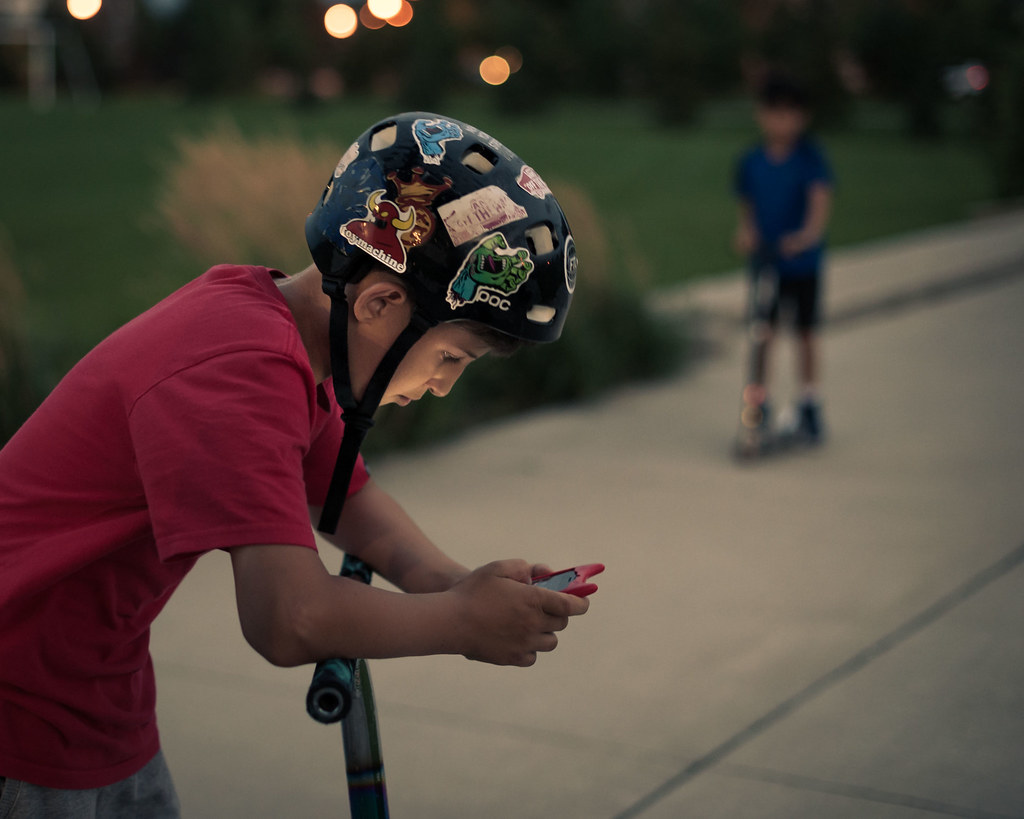Have you ever been to a family gathering or a hangout with friends where someone is glued to their phone, eyes darting between the screen and the real world, as if they’re trying to keep one foot in each? It’s a scene that’s becoming increasingly common, and it’s not just teenagers who are the culprits. Adults, too, are often caught in the act, particularly when live sports are on the line. It’s a phenomenon that’s both amusing and slightly concerning, akin to the ‘iPad kids’ of the digital era, but all grown up.
The Impact of Screen Time on Adult Social Dynamics
Let’s dive into this quirky aspect of modern social etiquette, or perhaps the lack thereof, and explore the implications of this behavior. It’s a topic that’s ripe for a chuckle, but also one that invites us to ponder the changing landscape of human interaction in the age of smartphones.
The adult version of ‘iPad kids’ is a term that’s as cheeky as it is accurate. Picture this: a group of friends or family members gathered together, ostensibly to enjoy each other’s company. Yet, there’s always that one person who can’t seem to tear themselves away from the tiny screen in their hands. They’re half-listening, half-watching, and fully absorbed in the latest game or match. It’s a sight that’s become all too familiar, and it’s not just a faux pas; it’s a cultural shift.
This behavior is not just about the allure of live sports; it’s about the broader implications of screen time and its intrusion into our social lives. The statistics are alarming: rates of depression and anxiety in the United States have risen by more than 50 percent from 2010 to 2019, with the suicide rate for adolescents ages 10 to 19 increasing by 48 percent. For girls ages 10 to 14, it’s an even more staggering 131 percent increase. These trends are not isolated to the U.S.; they’re a global phenomenon, affecting countries like Canada, the U.K., Australia, New Zealand, and the Nordic countries.
As we chuckle at the image of the ‘socially absent’ sports fan, it’s worth considering the broader context of these statistics. The rise in mental health issues coincides with the advent of the smartphone era. The oldest members of Generation Z, who grew up with this technology, are now in their late 20s and are exhibiting signs of prolonged adolescence. They’re dating less, having less sex, and showing less interest in starting families. They’re more likely to live with their parents and are perceived as harder to work with by managers.
The shift in behavior among adults who can’t put down their phones during social gatherings is just one facet of a much larger issue. It’s not just about missing out on the conversation at the dinner table; it’s about the cumulative effect of screen time on our mental health and social skills.
Don’t get too somber just yet. After all, there’s a certain irony in adults scolding children for too much screen time, only to fall into the same trap themselves. It’s as if the digital world has cast a spell on us, making us crave the constant stimulation it provides, even at the cost of real human connection.
What’s the solution? Do we need to start implementing ‘Screen Time’ restrictions for adults, just as we do for children? It’s a humorous thought, but perhaps not entirely out of the question. After all, if we’re to believe the experts, the intrusion of smartphones and social media into our lives is altering our developmental processes and interfering with our ability to mature into competent adults.

Addressing the Issue and Finding a Balance
In this first section, we’ve explored the amusing yet concerning trend of adults behaving like ‘iPad kids.’ We’ve looked at the statistics that suggest a correlation between increased screen time and mental health issues. We’ve also considered the broader implications of this behavior on our social skills and development as adults. In the next section, we’ll delve deeper into the impact of screen time on adult social dynamics and mental health, and perhaps find some strategies to strike a balance between our digital and real-world lives.
As we continue our exploration of the ‘adult iPad kids’ phenomenon, it’s time to dive into the impact of screen time on adult social dynamics and mental health. The image of someone half-present in a social setting, their attention hijacked by the live sports streaming on their phone, is not just a breach of social etiquette; it’s a symptom of a larger issue that’s affecting our mental well-being and the fabric of our social interactions.
The rise of screen time has coincided with a notable decline in mental health, particularly among the younger generations who have grown up in the smartphone era. But it’s not just the youth who are affected; adults are also feeling the brunt of this digital invasion. The constant pull of notifications, the allure of a never-ending stream of content, and the dopamine hits from social media likes and shares are shaping our behavior in ways we’re only beginning to understand.
Consider the social dynamics at play when adults choose to watch sports on their phones instead of engaging with the people around them. It’s not just that they’re missing out on the conversation and the shared experiences; they’re also contributing to a culture where being physically present isn’t synonymous with being socially engaged. This behavior sets a precedent, one that says it’s acceptable to prioritize digital interaction over face-to-face communication.
The consequences extend beyond social faux pas. The mental health implications are significant. The same screens that provide us with endless entertainment are also sources of stress and anxiety. The pressure to stay connected and the fear of missing out (FOMO) can lead to feelings of inadequacy and isolation, even when we’re surrounded by others. It’s a paradox of our times: we’re more connected than ever before, yet many of us feel lonelier than ever.
The statistics are alarming. The increase in emergency-department visits for nonfatal self-harm, the rise in depression and anxiety rates, and the decline in academic achievement all point to a society grappling with the consequences of a digitally dominated lifestyle. The correlation between these trends and the rise of smartphone use cannot be ignored. As we’ve seen, the early 2010s marked a significant shift in how adolescents—and now adults—spend their time, with much of it being funneled into the digital realm.

This shift has also affected how adults approach risk and ambition. The cautionary tales of online missteps and the curated perfection seen on social media can lead to a more risk-averse mindset. This can stifle creativity and ambition, as evidenced by the observation that Silicon Valley’s leading entrepreneurs are no longer in their 20s. The drive to innovate and take risks, once the hallmark of youth, seems to be waning in the face of an online culture that often punishes failure and rewards conformity.
What can we do to mitigate these effects? It’s clear that a cultural correction is needed. We must find ways to balance our online and offline lives, to reclaim the social skills and mental resilience that come from face-to-face interactions. This might mean setting personal limits on screen time, fostering environments that encourage in-person socialization, or simply making a conscious effort to put our phones away during social gatherings.
It’s also important to recognize the role of play and independence in our development. The decline of play and the lack of opportunities for unsupervised risk-taking have had profound effects on our ability to cope with challenges and build social bonds. We need to reintroduce these elements into our lives, to give ourselves the chance to learn, grow, and connect in meaningful ways.
While the image of adults watching live sports on their phones in social settings might be a source of humor, it’s also a reflection of deeper issues within our society. The impact of screen time on our social dynamics and mental health is a complex problem that requires thoughtful consideration and action. By acknowledging the issue and taking steps to address it, we can begin to heal the divide between our digital and real-world lives, and foster a society that values presence, connection, and well-being.
Related posts:
End the Phone-Based Childhood Now
Dear Annie: Why do parents bother coming to watch their kids compete if they’re going to stare at their phones the whole time?
How I (Mostly) Stopped My Teen From Gaming All Night





:max_bytes(150000):strip_icc():focal(737x230:739x232)/Multiretailer-Celebrity-Track-Pants-011325-01-c9599cb19b91422c9c4840253f7f3c92.jpg)